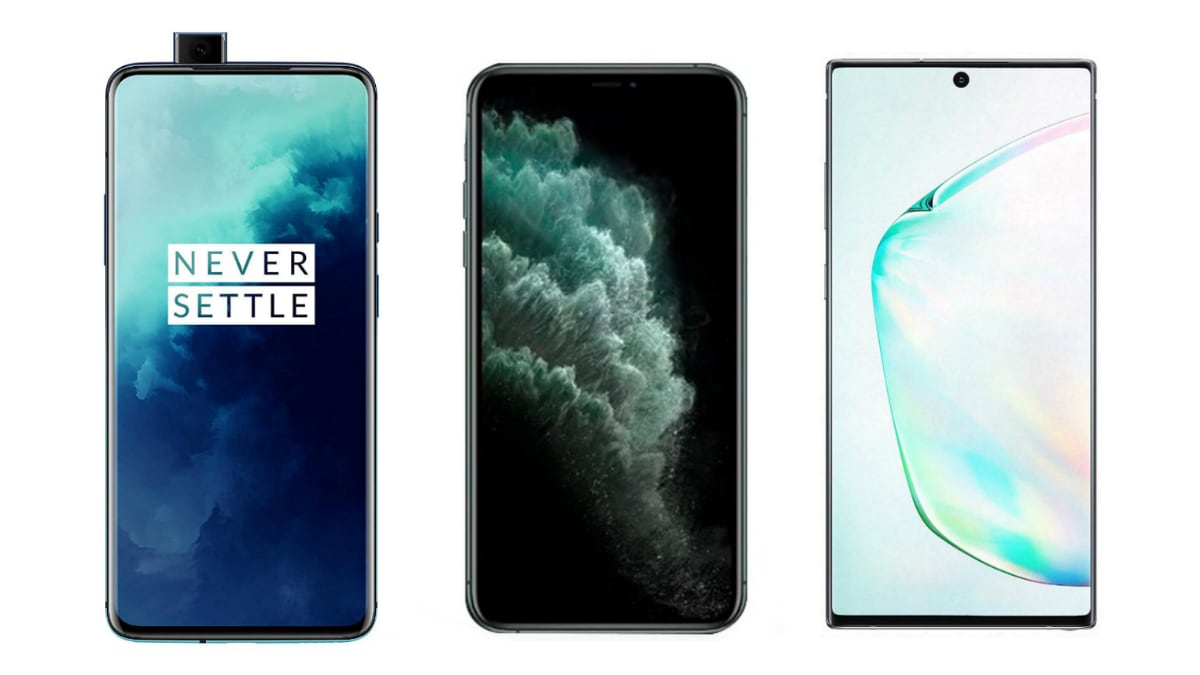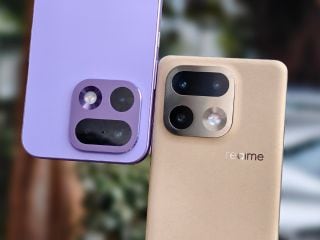- Home
- Mobiles
- Mobiles Features
- OnePlus 7T Pro vs iPhone 11 Pro Max vs Samsung Galaxy Note 10+: Price in India, Specifications Compared
OnePlus 7T Pro vs iPhone 11 Pro Max vs Samsung Galaxy Note 10+: Price in India, Specifications Compared
OnePlus 7T Pro price in India is set at Rs. 53,999, while iPhone 11 Pro Max price starts at Rs. 1,09,900 and Samsung Galaxy Note 10+ begins at Rs. 79,999.

OnePlus 7T Pro, iPhone 11 Pro Max, and Samsung Galaxy Note 10+, all three carry a premium design
OnePlus 7T Pro was launched in India earlier this week as the latest flagship by the Chinese company. The new OnePlus phone carries the legacy of the OnePlus 7 Pro with a pop-up selfie camera and an edge-to-edge display. However, the OnePlus 7T Pro also includes various upgrades over its predecessor. The new smartphone runs Android 10 out-of-the-box and is powered by the Qualcomm Snapdragon 855+ SoC. There is also a triple rear camera setup -- sporting a 48-megapixel primary sensor. All this makes the OnePlus 7T Pro a strong contender against the flagship phones from other companies, including iPhone 11 Pro Max and Samsung Galaxy Note 10+.
In this article, we compare the price and specifications of the OnePlus 7T Pro with those of the iPhone 11 Pro Max and Samsung Galaxy Note 10+ to see how the new OnePlus phone stacks up against the Apple and Samsung flagships.
OnePlus 7T Pro vs iPhone 11 Pro Max vs Samsung Galaxy Note 10+ price in India
The OnePlus 7T Pro price in India is set at Rs. 53,999 for the lone 8GB RAM + 256GB storage option. The phone comes in a single, Haze Blue colour option. In contrast, the iPhone 11 Pro Max price in India starts at Rs. 1,09,900 for the 64GB storage option. The new iPhone model also has the 256GB storage option at Rs. 1,23,900 and 512GB storage variant at Rs. 1,41,900. All three options come in Gold, Midnight Green, Silver, and Space Grey colour options.
The Samsung Galaxy Note 10+ price in India, on the other hand, is set at Rs. 79,999 for the 256GB storage option, while its 512GB storage variant carries a price tag of Rs. 89,999. The phone comes in Aura Black, Aura Glow, and Aura White colours.
OnePlus 7T Pro vs iPhone 11 Pro Max vs Samsung Galaxy Note 10+ specifications
The dual-SIM (Nano) OnePlus 7T Pro runs Android 10 with OxygenOS 10.0 on top. This is unlike the dual-SIM iPhone 11 Pro Max that runs iOS 13 out-of-the-box, while the dual-SIM (Nano) Samsung Galaxy Note 10+ runs Android 9 Pie with the latest One UI on top. On the display front, the OnePlus 7T Pro houses a 6.67-inch QHD+ (1440x3120 pixels) Fluid AMOLED display with 90Hz refresh rate and 19.5:9 aspect ratio. The iPhone 11 Pro Max features a 6.5-inch (1241x2688 pixels) Super Retina XDR OLED display with 60Hz refresh rate and 19.5:9 aspect ratio. The Galaxy Note 10+ has a 6.8-inch QHD+ (1440x3040 pixels) Infinity-O Display with a Dynamic AMOLED panel that has 60Hz refresh rate and 19:9 aspect ratio.
Under the hood, the OnePlus 7T Pro packs the octa-core Qualcomm Snapdragon 855+ SoC, paired with Adreno 640 GPU and 8GB of LPDDR4X RAM. The iPhone 11 Pro Max has Apple's A13 Bionic SoC with third-generation Neural Engine. Apple doesn't disclose the RAM details. The Samsung Galaxy Note 10+, on the other front, has the octa-core Exynos 9825 SoC, coupled with 12GB of RAM.
In terms of optics, the OnePlus 7T Pro features the triple rear camera setup that consists of a 48-megapixel Sony IMX586 primary sensor with an f/1.6 lens and optical image stabilisation (OIS) as well as electronic image stabilisation (EIS) support. The camera setup also features an 8-megapixel sensor with an f/2.4 telephoto lens and OIS support and a 16-megapixel sensor with an f/2.2 ultra-wide-angle lens that offers a field of view (FoV) of 117 degrees. However, the iPhone 11 Pro Max has three distinctly-placed 12-megapixel cameras sensors that are accompanied by f/1.8 wide-angle, f/2.4 ultra-wide-angle, and f/2.4 telephoto lenses. Unlike the OnePlus 7T Pro and iPhone 11 Pro Max, the Galaxy Note 10+ houses a quad rear camera setup that includes a 12-megapixel primary sensor along with a wide-angle (77 degrees) lens that sports a variable aperture (f/1.5-f/2.4) and has optical image stabilisation (OIS). The setup also includes a 16-megapixel secondary sensor with an ultra-wide-angle (123 degrees) lens that has an f/2.2 aperture, a 12-megapixel tertiary sensor with an f/2.1 telephoto lens (45 degrees) and OIS support, and a fourth DepthVision camera that has VGA resolution.
For selfies, the OnePlus 7T Pro has a 16-megapixel Sony IMX471 camera sensor in the pop-up module that includes an f/2.0 lens. The iPhone 11 Pro Max, on the other hand, comes with a 12-megapixel f/2.2 selfie shooter, whereas the Samsung Galaxy Note 10+ has a 10-megapixel camera sensor at the front with an f/2.2 lens that has an 80-degree field of view.
The OnePlus 7T Pro comes with 256GB of onboard storage that isn't expandable via microSD card. The iPhone 11 Pro Max has 64GB, 256GB, and 512GB storage options, whereas the Samsung Galaxy Note 10+ is offered in 256GB and 512GB storage options and both are expandable via a microSD card slot (up to 1TB).
Connectivity options on the OnePlus 7T Pro include 4G VoLTE, Wi-Fi 802.11ac, Bluetooth v5.0, GPS/ A-GPS, NFC, and USB Type-C. The iPhone 11 Pro Max also has 4G VoLTE as well as Wi-Fi 6, Bluetooth v5.0, GPS/ A-GPS, NFC, and a Lightning port. These are similar to the Samsung Galaxy Note 10+ that has 4G (LTE Cat. 20), Wi-Fi 802.11ax, Bluetooth v5.0, NFC, MST, and GPS/ A-GPS, but except a USB Type-C port in place of Apple's proprietary Lightning port.
Samsung Galaxy Note 10+ Review
The OnePlus 7T Pro packs a 4,085mAh battery that supports Warp Charge 30T technology. While Apple hasn't confirmed the battery capacity of the iPhone 11 Pro Max, it is reported to be 3,969mAh. There is also 18W fast charging support. The Galaxy Note 10+, on the other hand, houses a 4,300mAh battery that supports up to 45W fast charging.
Dimensions of the OnePlus 7T Pro are 162.6x75.9x8.8mm while the iPhone 11 Pro Max measures 158x77.80x8.10mm and the Galaxy Note 10+ comes at 162.3x77.2x7.9mm. The OnePlus phone weighs 206 grams that is lighter than the 226-gram iPhone 11 Pro Max but slightly heavier than the 196 grams weight of the Samsung Galaxy Note 10+.
Catch the latest from the Consumer Electronics Show on Gadgets 360, at our CES 2026 hub.
Related Stories
- Samsung Galaxy Unpacked 2025
- ChatGPT
- Redmi Note 14 Pro+
- iPhone 16
- Apple Vision Pro
- Oneplus 12
- OnePlus Nord CE 3 Lite 5G
- iPhone 13
- Xiaomi 14 Pro
- Oppo Find N3
- Tecno Spark Go (2023)
- Realme V30
- Best Phones Under 25000
- Samsung Galaxy S24 Series
- Cryptocurrency
- iQoo 12
- Samsung Galaxy S24 Ultra
- Giottus
- Samsung Galaxy Z Flip 5
- Apple 'Scary Fast'
- Housefull 5
- GoPro Hero 12 Black Review
- Invincible Season 2
- JioGlass
- HD Ready TV
- Laptop Under 50000
- Smartwatch Under 10000
- Latest Mobile Phones
- Compare Phones
- Motorola Signature
- Vivo Y50e 5G
- Vivo Y50s 5G
- Realme 16 Pro+ 5G
- Realme 16 Pro 5G
- TCL Nxtpaper 70 Pro
- OPPO A6 Pro 5G
- Honor Power 2
- Lenovo Legion 5a
- Lenovo Legion 5i
- Realme Pad 3
- OPPO Pad Air 5
- Xiaomi Watch 5
- Huawei Watch 10th Anniversary Edition
- Acerpure Nitro Z Series 100-inch QLED TV
- Samsung 43 Inch LED Ultra HD (4K) Smart TV (UA43UE81AFULXL)
- Asus ROG Ally
- Nintendo Switch Lite
- Haier 1.6 Ton 5 Star Inverter Split AC (HSU19G-MZAID5BN-INV)
- Haier 1.6 Ton 5 Star Inverter Split AC (HSU19G-MZAIM5BN-INV)




















